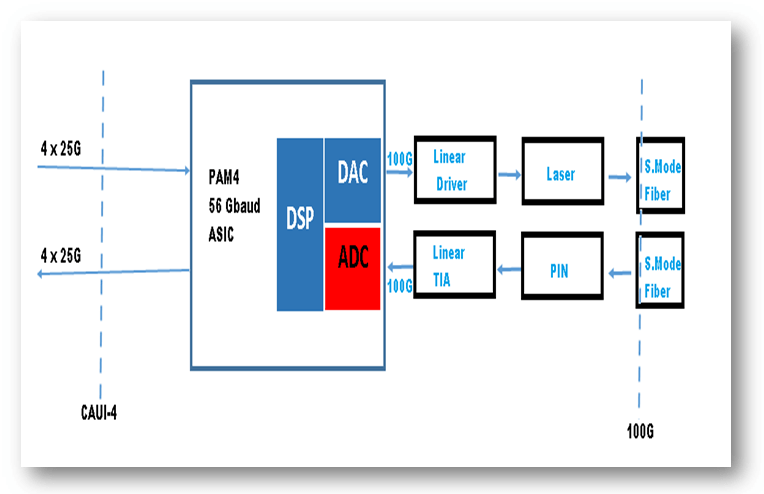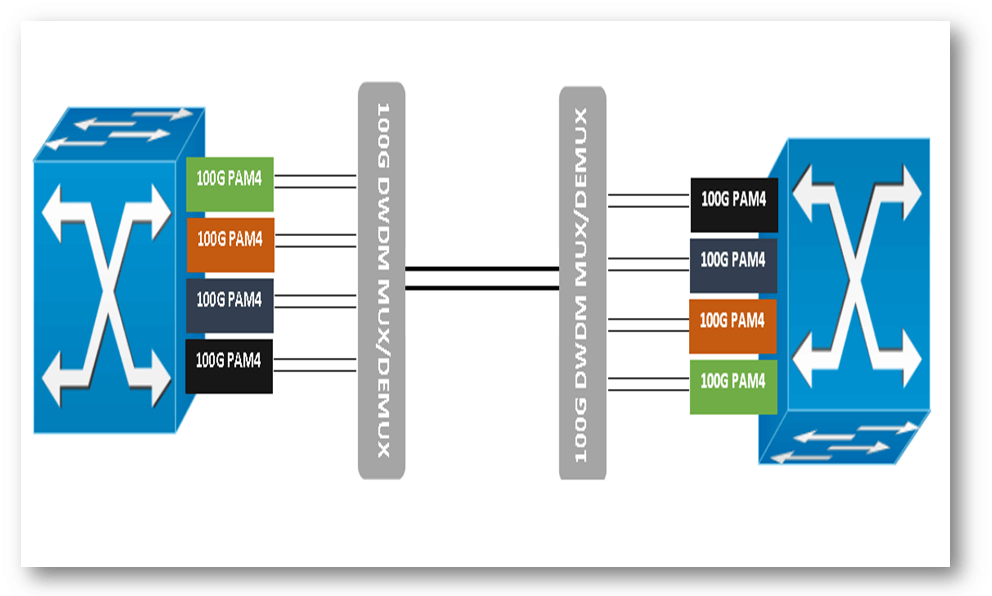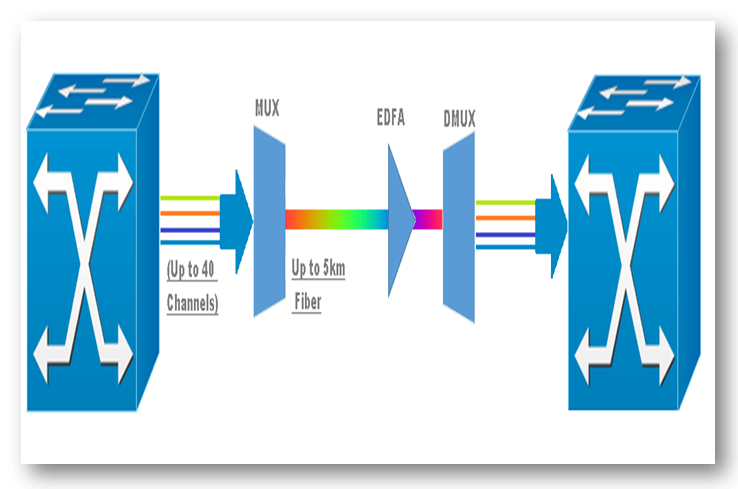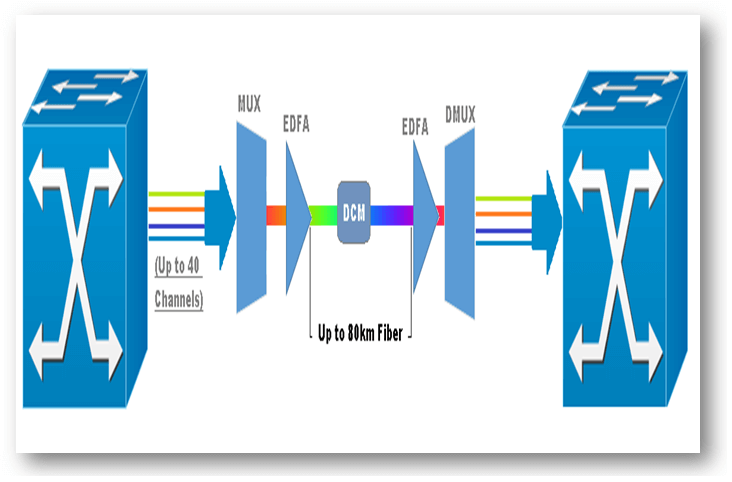Standard optical transmission transceivers including CFP and QSFP28 transceiver modules are quite efficient for 100G transmission within data centers. However, it becomes an issue as they cannot be used for transporting data over long distances like in cases where traffic is needed to be carried between multiple data centers, geographically dispersed and situated far from one another (say over 60 kilometers). Here comes the role of 100G DWDM QSFP28 transceivers.
DWDM technology is not new in the industry as DWDM SFP transceivers are widely used for the expansion of 10G network capacity. Regarding functionality, the 100G DWDM is quite similar to its predecessor. Though, it is typically used in 100G networks for transmission over longer distances.

100G DWDM QSFP28: The Broader Reach, More Agile Solution
100G DWDM QSFP28 works on an advanced and state-of-the-art modulation technique called PAM4. Moreover, it takes a form factor similar to QSFP transceiver modules and can directly be used on switches with available QSFP28 ports – capitalizing on the IEEE CAUI-4 4x 25G electrical interfaces. One of the significant benefits of DWDM QSFP28 PAM4 is its lower power consumption which makes it into a practical solution for data center interconnect applications.
Benefits of the PAM4 method
Before PAM4 (pulse amplitude modulation), binary NRZ modulation format is used for 100G long-haul and 40G data transmission networks. PAM4 is a better choice as it comes with four distinct levels for the encoding of two data bits. Thus, with this modulation format, the bandwidth of a connection can be double. These days, the single-wavelength PAM4 modulation technique is being used as it is considered as the most efficient and cost-effective enabler of 100G data transportation.
Customers who are willing to construct an embedded DWDM data network can employ these transceivers in their switches directly. Therefore, it is a cost-effective and simple solution. However, PAM4 requires amplification, and you cannot go beyond the range of 5 to 6 kilometers without using dispersion compensation. Thus, a dedicated DWDM multiplexer in combination with dispersion compensation and an amplification system is necessary to connect data centers using PAM4.

The advent of Pluggable 100G DWDM QSFP28 Transceivers
In the past few years entire focus remained on coherent DWDM optical transceivers including but not limited to CFP and CFP2. Back in 2016, Inphi (a leading vendor in communications industry) launched the pluggable 100G DWDM QSFP28 transceivers for the very first time.
The introduction of pluggable DWDM QSFP28 transceivers was received like a strong alternative for 100G DWDM coherent transceivers. It triggered a major shift as a significant number of network operators started shifting to 100G DWDM QSFP28 transceivers.
100G DWDM QSFP28 – an Ultimate Answer for the anticipated Data Centers Interconnect Boom
The growth of e-commerce, social networking, and big data is driving the demand for bandwidth between data centers. This factor is motivating data center operators to deploy low power, high-density and low latency DWDM links to connect their multiple data centers. In fact, Data centers interconnect (DCI) today has become a basic necessity of businesses.
Far located data centers are connected to meet various crucial needs such as: disaster recovery, cluster computing, large-scale data transfers and also for the erection of metro data center topologies. Data-intensive applications including Artificial intelligence, server-less compute and machine learning are inducing a rapid growth in the construction of cloud networks.
As per AGC research, in 2019 the global market for optical data center interconnect (DCI) will hit the $4.7 billion mark. You can suggest that the QSFP28 form factor compatible 100G DWDM modules are ready to replace 10G DWDM technology which is still being used in a significant portion of sub 80 kilometer lines.
Large Data Centers vs. Regional Data Centers
Restraints in the building of massive data centers are enforcing cloud service providers (CSPs) to move towards distributed regional architectures. It is because the construction of large-scale data centers is not always achievable due to:
- Power constraints
- Real estate limitations
- Legal issues
- Cost-related issues
In short, to provide applications agility and to maintain seamless content delivery interconnecting geographically dispersed or regional data centers becomes a practical and more affordable solution.
 Case I: under 5 km Applications
Case I: under 5 km Applications  Case II: over 5 km Applications (up to 80km)
Case II: over 5 km Applications (up to 80km)
Implementation of the 100G DWDM QSFP28 Transceiver
With its capability to deliver as much as 4Tbps of bandwidth for up to 80 kilometers spread between data centers the 100G DWDM QSFP28 can be considered as a perfect solution. The construction of a 100G DWDM QSFP28 based long distance interconnection setup requires:
- Optical Multiplexer/Demultiplexer
- Optical Pre-Amplifier and Post-Amplifier
- Dispersion Compensator ( for greater then 5-kilometer applications only)
In this arrangement, the Optical Multiplexer (MUX) syndicates various wavelengths of light into a single fiber strand, and Erbium-doped fiber amplifiers aka EDFAs are employed to boost the signal. For applications greater then 5 kilometers, a dispersion compensator is required (as shown in Case II). Whereas no dispersion compensator is needed in scenarios where the distance remains less than 5 kilometers.
General Characteristics of available 100G DWDM QSFP28 Pluggable Modules:
The 100G DWDM QSFP28 pluggable modules are widely considered as a viable solution for Metro Data Center Interconnect (DCI) with a possibility of transmission over 80 kilometers at a speed of 100 Gigabits/s.
These transceivers employ an IEEE CAUI-4 4x25G interface, and they come compatible with standard 100G QSFP28 ports. As far as their optical capabilities are concerned, the 100G QSFP28 pluggable modules can combine two different wavelengths into a single duplex fiber with its center wavelength aligned with the 100GHz grid.
The DWDM QSFP28 is obtainable in 40 diverse channels on the 100GHz ITU-T based grid to offer up to 4Tbps maximum bandwidth over a single fiber pair. Following features can be anticipated by a 100G DWDM QSFP28 module:
- Easy integration with existing optical line infrastructure
- PAM4 modulation format possible for smaller size QSFP28 setups
- High capacity, reliable bandwidth throughout metro reach optical fiber network
- Scalable solution for 100Gbps to 4Tbps
- Offered in the form of hot-swappable pluggable devices
The Beauty of Pluggable 100G DWDM QSFP28 Transceivers
Enterprises and data centers can deploy pluggable transceivers and transponders in various combinations according to their specific requirements. The extension of a handy embedded DWDM approach to 100G line speeds can keep complexities and costs out of Datacom networking. Pluggable 100G transceivers allow enterprises to experience the comprehensive benefits of open, flexible line networking. Moreover, pluggable 100G transceivers available on the market are relevant and practical with various already existing network configurations.
 English
English
 Deutsch
Deutsch
 Espaniol
Espaniol










